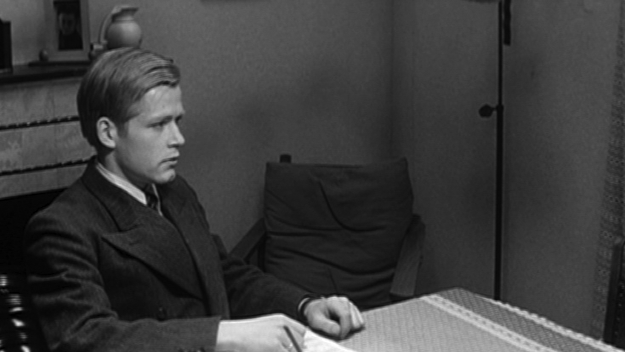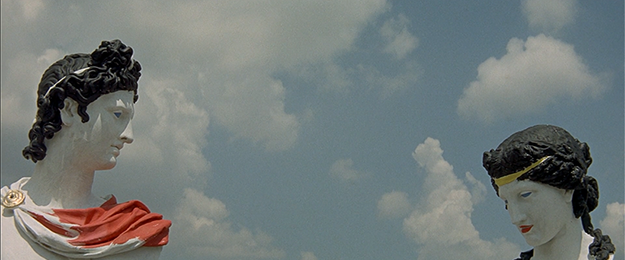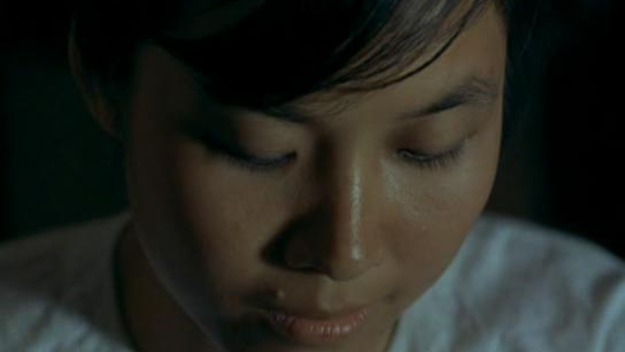The Dark Room of Damocles In retrospect, much seems improbable about Raoul Coutard’s rise to fame as the premier cinematographer of the French New Wave. A veteran of the French Indochina War and an experienced magazine photojournalist, Coutard—the subject of a tribute in Film Comment Selects with screenings February 19 and 22—never shared the radical politics of such figures as Agnès Varda or Jean-Luc Godard. He irreverently called himself “a fascist of the right” who, in the long collaboration he sustained with Godard, made a kind of alliance with a “fascist of the left.” According to his own well-known—and possibly exaggerated—account, the documentarian Pierre Schoendoerffer, an old military friend, first conned Coutard into shooting a movie by asking him to “do the photos.” About filming Godard’s Breathless (1959)—a job he landed through the intervention of the benevolent producer Georges de Beauregard—he insisted that “if I had known what was involved in shooting a handheld film without lighting, I would not have done it.” Coutard was born in 1924 and lived in Paris through the Occupation. If he did indeed stumble blindly into what would become his line of work, he adapted to it with remarkable speed and skill. To accommodate Godard’s ramshackle, quick-changing shooting habits and the production’s meager budget, he shot Breathless with the same handheld Eclair Cameflex camera he’d used on his early documentary work. With very few exceptions, he had to make do with whatever light happened to be at hand. Coutard was perhaps unusually comfortable shooting in tense settings with thin resources: in the 1950s, for years after his tour of duty, he had stayed in Vietnam and made his living selling war pictures to such papers as Paris Match. He was, in any case, a fast learner. Between 1960 and 1964, he shot more than twenty features for Godard, François Truffaut, Jacques Demy, Edgar Morin, Jean Rouch, and a cluster of intriguing lesser-known figures like Jacques Baratier (La Poupée) and the Dutch director Fons Rademakers (The Dark Room of Damocles). It would have been an astonishing run by any measure, and it seems still more so in view of how high a standard most of his projects met. (He would make 17 films with Godard in total, the last of which was 1982’s Prénom Carmen.) During these early years he quickly refined his technique: according to Benjamin Bergery, who wrote what remains a definitive article on Coutard for American Cinematographer in 1997, “He developed a fast and flexible system for location lighting that simply entailed aiming a dozen ordinary 500-watt Photoflood-type bulbs at silver reflective material taped to the ceiling,” an arrangement that gave the director the freedom to set up a shot “from virtually any angle in the room below.”
Contempt Coutard was so skilled with a handheld camera and responsive to improvisation that critics and fans have tended to associate him with his most freewheeling or mobile images: the sprint three characters make through the Louvre in Godard’s Band of Outsiders (1964); the spontaneous foot race another trio undertakes down a bridge in Truffaut’s Jules and Jim (1962); the smooth, complicated dolly shots in Godard’s Contempt (1963). He’s rightly considered a master of offhand lighting and a genius at bringing out bold primary colors, like the bright reds—clothes, walls, stoplights, blotches of blood—that fill Made in U.S.A (1966) or the deep blue of the sea that becomes the backdrop for a romantic breakdown in Pierrot le fou (1965). What’s more often overlooked about Coutard is the way his shots, even at their briskest and most restless, almost always seem to gravitate toward a kind of equilibrium and balance—a strong center of gravity that both permits wide improvisation and keeps it in check. He would have preferred, he told Bergery, to do “Rembrandt-type lighting, rather than the low-contrast of the early films” he made at the height of the New Wave, and much of his work seems to aspire to a kind of fussily arranged, impeccably lit portraiture. Even from within the chaotic, maddening environments of Godard’s shoots, Coutard was able to capture images of haunting stillness like the close-up profile shots of Anna Karina that open Vivre sa vie (1962), the tableau-like portraits of Karina interacting with Eddie Constantine that show the couple’s growing affection in Alphaville (1965), or the tight images of torsos and limbs that make up the fragmentary lovemaking scenes in A Married Woman (1964). Of Coutard’s early films, it was in Lola (1961)—Jacques Demy’s tender debut, a hymn to a cabaret dancer in Nantes—that he had a chance to indulge more fully in the kind of stately elegance he often seemed to court. But the greatest flowering of that impulse came much later in his life, with his work for the troubled and staunchly independent Philippe Garrel. Their collaboration on Wild Innocence (2001), the last film Coutard shot, resulted in a magisterial stream of black-and-white images in which still lives of inanimate objects—a phone; a film script; a photograph; a needle left out on a porcelain bathroom counter—and close-up portraits of the film’s beautiful actors alternated with tracking shots so light that the camera seemed to be floating on air.
Hoa-Binh Coutard’s career rose and fell with the New Wave. After the two films he shot for Costa-Gavras in the early 1970s—Z (1969) and The Confession (1970)—there followed dozens of low-profile projects with less distinguished directors. The details of his falling-out with Godard remain unclear (in a 2002 profile, he hinted at a dispute with Godard’s partner Anne-Marie Miéville). In any event, their partnership ended in 1982, two years before Truffaut’s early death. At the start of the Seventies, Coutard made a promising debut as a director with Hoa-Binh (1970), a delicate, understated war film about two displaced Vietnamese children—a boy and his younger sister—struggling to get by in the midst of the American invasion. A beguiling movie that makes up for some clumsily staged scenes with an abundance of precise observations, vivid close-ups and immersive environmental details, it earned strong notices and an Oscar nomination for best foreign-language film, and deserves a brighter profile than it’s since had. But his subsequent two efforts as a director—a second, Africa-set war film and a schlocky spy thriller—went by practically unnoticed. The major development of Coutard’s later years was his partnership with Garrel, which gave him a brief but decisive creative resurrection. Midway through Wild Innocence, the two of them staged a scene that could be seen as a kind of pendant to Coutard’s career—a vision of cinematography as an elegant, enveloping dance. The movie concerns a filmmaker who’s made dire compromises to fund a feature about his former lover, a model who died of a heroin overdose. (He casts his current partner in the part.) The scene in question shows the first shoot of the film-within-the-film: a nocturnal masquerade party in an old empty house. We watch the director at the center of Garrel’s movie and his film crew follow the archaically dressed partygoers across a bridge; then, after a cut, we enter the movie they’re filming. For two minutes, to the sound of a young Van Morrison singing “Friday’s Child,” we circulate among them as they dance and mingle and talk wordlessly. When the central character leaves the shot, a cut brings us to a wider shot of the camera dollying slowly and smoothly past the extras as they dance and spin quickly to the cresting music. The rest of Wild Innocence dwells bitterly on the moral and emotional taxes the production will level on its director and star. But in this scene, we’re given a rare glimpse of what Coutard, one senses, always wanted the act of filming to look like: a surge of bustling activity corralled into the frame with serenity, grace, and poise. Max Nelson is an editorial assistant at The New York Review of Books and a frequent contributor to Film Comment.


